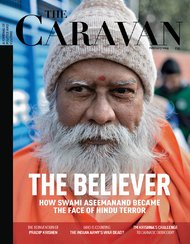NEW DELHI — From 2006 to 2008, a series of bomb attacks hit civilian targets around India, the deadliest of which was on Feb. 18, 2007, when 68 people died on a train traveling to Pakistan. Swami Aseemanand, a former activist with the influential Hindu nationalist group Rashtriya Swayamsevak Sangh, or R.S.S., has been charged with plotting five of these attacks, which collectively killed 119 people.
Leena Gita Reghunath, editorial manager at The Caravan, a monthly newsmagazine, interviewed Swami Aseemanand four times over the course of more than two years while he was in prison in Ambala, Haryana state, pending trial. Her cover story for the February issue of The Caravan contains explosive revelations from Swami Aseemanand, who told Ms. Reghunath that the attacks were sanctioned by senior Rashtriya Swayamsevak Sangh officials like Mohan Bhagwat and Indresh Kumar. The organization has denied the report.
Since the story was published, The Caravan’s offices in Mumbai and New Delhi have received threatening phone calls. On Friday afternoon, about 100 people gathered in front of the magazine’s office in New Delhi and burned copies of the latest edition of The Caravan.
Meanwhile, in a handwritten letter to TV news channels, Swami Aseemanand has denied giving any such interviews to The Caravan. In response, the magazine released audio tapes and transcripts of the over nine hours of interviews.
Ms. Reghunath spoke with India Ink by phone and email on Monday about the reaction to the story and how it has affected her.
I went about collecting documents of the cases, wherein I came across the very interesting chargesheet of Samjhauta. And then I wrote a 150-word pitch and submitted it to the editor. And he agreed to send me on a recce to know whether I could meet the Swami.
And so I had to go back to hear it again from Aseemanand to make sure he really meant it, and there it was, he repeated it once again to me, sticking to his lines. And then we realized the story reached its peak of the reporting, and we did whatever we could, and then we had to get it to the public at the earliest.
It is very worrying that the so called secular parties—the Congress and the Left included—are so guarded in their reactions to the very threat to democracy that this article exposes, and are shying away from their responsibility to this country and its people.
(This interview has been lightly edited and condensed.)
Published in: The New York Times
Published on: February 10, 2014
Link: https://india.blogs.nytimes.com/2014/02/10/a-conversation-with-leena-gita-reghunath-editorial-manager-at-the-caravan-magazine/


